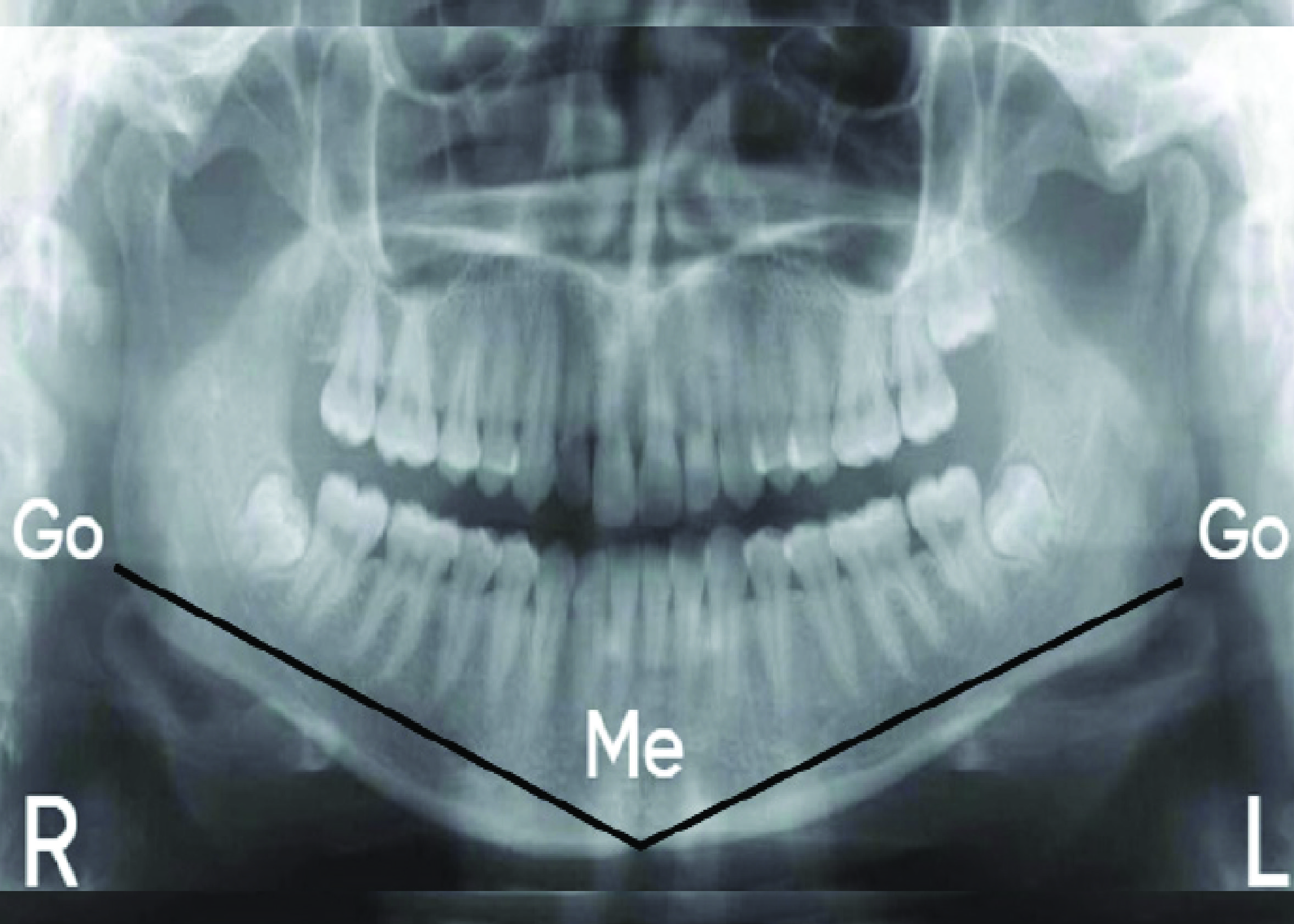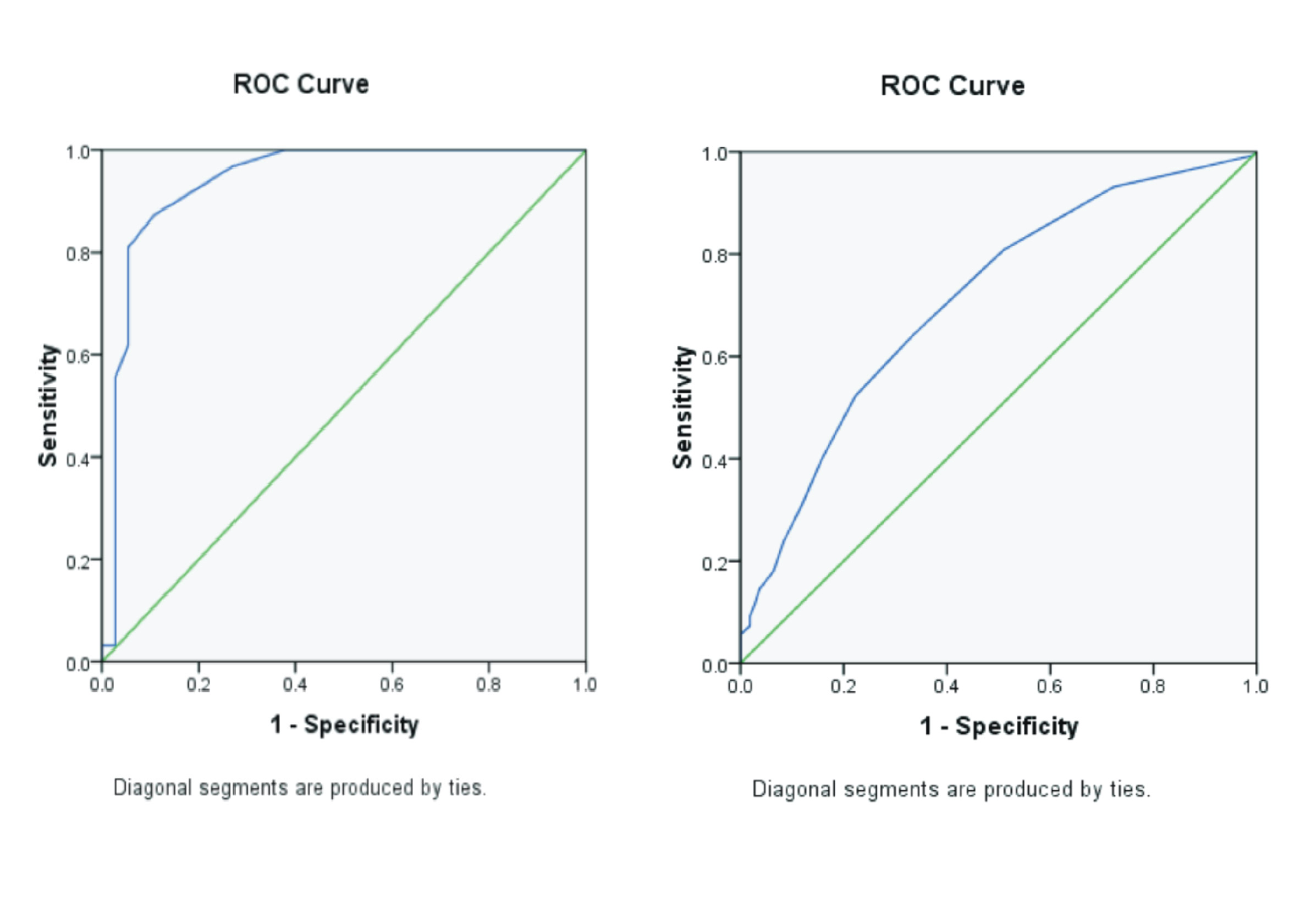MANDIBULAR RADIOGRAPHIC ANALYSIS FOR GENDER DETERMINATION OF DOWN SYNDROME SUFFERERS

Downloads
Background: Natural disasters frequently occur in Indonesia, creating a need for effective victim identification. Gender identification is a crucial initial step, as it can narrow the search space by 50% during individual identification. The corpus and ramus mandible are an organ that plays an important role in gender prediction with a high predictive accuracy. However, the Down syndrome mandibular size is different from that of normal people. Purpose: To analyze the difference in corpus length and total height of the mandibular ramus between individuals with down syndrome and those without, as a step to gender determination. Method: This observational cross-sectional study involved 12 individuals with down syndrome and 12 individuals without, aged 10 – 17 years. The mandibular corpus length was measured through panoramic radiography from the gonion to the menton point. The mandibular ramus was measured from the apex of the condyle to the gonion point using the Clinicview application. Data were analyzed using the T-test with SPSS Ver. 26 software. Result: The length of the mandibular corpus differs significantly (p-value = 0.000) between Down syndrome with normal people. The length of the mandibular corpus in down syndrome does not differ significantly (p-value > 0.000) between males and females. The total height of the mandibular ramus does not differ significantly between down syndrome and non-down syndrome groups, both in males and females. Conclusion: The corpus length and the mandibular ramus's total height cannot be used as indicators of gender determination in down syndrome.
Ardani, I.G.A.W., 2023. Dasar Pertumbuhan Kraniofasial Setelah Kelahiran, Airlangga University Press. Airlangga University Press, Universitas Airlangga.
Astuti, E., Iskandar, H., Nasutianto, H., Pramatika, B., Saputra, D., Putra, R., 2021. Radiomorphometric of The Jaw for Gender Prediction: A Digital Panoramic Study. Acta Medica Philippina Vol. 56(3), Pp. 1-9.
Azhari, A., Pramatika, B., Epsilawati, L., 2019. Differences between Male and Female Mandibular Length Growth According to Panoramic Radiograph. Majalah Kedokteran Gigi Indonesia Vol. 1(1), Pp. 43.
Capitaneanu, C., Willems, G., Thevissen, P., 2017. A Systematic Review of Odontological Sex Estimation Methods. The Journal of Forensic Odonto-Stomatology Vol. 35(2), Pp. 1-19.
Carinhena, G., Siqueira, D.F., Sannomiya, E.K., 2014. Skeletal Maturation in Individuals with Down’s Syndrome: Comparison between Pgs Curve, Cervical Vertebrae and Bones of The Hand and Wris. Dental Press Journal of Orthodontics Vol. 19(4), Pp. 58-65.
Cordner, S., 2018. Humanitarian Forensic Science. Australian Journal of Forensic Sciences Vol. 279, Pp. 65-71
Dierssen, M., Fructuoso, M., Martínez de Lagrán, M., Perluigi, M., Barone, E., 2020. Down Syndrome is A Metabolic Disease: Altered Insulin Signaling Mediates Peripheral and Brain Dysfunctions. Front Neurosci Vol. 14, Pp. 670.
Ekkarandy, R.D., Arafat, M.R., 2021. Identifikasi Forensik terhadap Korban Kecelakaan Massal (Pesawat) di Tinjau dari Ilmu Kedokteran Forensik. Jurnal Hukum Postium Vol. 6(2), Pp. 273–283.
Elfitri, T., Firdaus, F., Iswani, R., 2017. Analisis Besar Sudut Gonial Mandibula Berdasarkan Hasil Rontgen Panoramik untuk Identifikasi Jenis Kelamin pada Suku Minang. B-Dent: Jurnal Kedokteran Gigi Universitas Baiturrahmah Vol. 4(1), Pp. 15-22.
Interpol, 2023. Disaster Victim Identification Guide.
Irwanto, Henry, W., Aini, A., Mariana, S.S., 2019. A-Z Sindrom Down, 1st ed, Universitas Airlangga. Airlangga University Press, Surabaya.
Joo JK, Lim YJ, Kwon H, A.S., 2013. Panoramic Radiographic Evaluation of The Mandibular Morphological Changes in Elderly Dentate and Edentulous Subjects. Acta Odontologica Scandinavica Vol. 71(2), Pp. 357–62.
Kaur, R., Pallagatti, S., Aggarwal, A., Mittal, P.G., Singh, M., Patel, M.L., 2021. Mandibular Ramus as A Strong Expressor of Sex Determinations: A Digital Radiographic Study. Journal of Pharmacy & Bioallied Sciences Vol. 13(Supp.1), Pp. S421-S424.
Lamfon, H., Beyari, M. El, Fansa, H., Khalifa, M., 2015. The Prevalence of Oral and Dental Anomalies in Mentally Retarded Children in Makkah Community. International Journal of Health Sciences & Research Vol. 5, Pp. 4.
Macho, V., Coelho, A., Areias, C., Macedo, P., Andrade, D., 2014. Craniofacial Features and Specific Oral Characteristics of Down Syndrome Children. Oral Health Dent Manag Vol. 13(2), Pp. 408-411.
Ministry of Health, 2018. InfoDatin: Antara Fakta dan Harapan Sindrom Down.
Muhammad, M., Kamil, H., Adlim, M., Irwandi, I., 2024. Constraints on Transport of Injured Victims after The Earthquake for Disaster Victims’ Evacuation Model Development: A Phenomenological Study. Heca Journal of Applied Sciences Vol. 2(1), Pp. 1-10.
Nadendla, L.K., Paramkusam, G., Pokala, A., Devulapalli, R.V., 2016. Identification of Gender using Radiomorphometric Measurements of Canine by Discriminant Function Analysis. Indian Journal of Dental Research: Official Publication of Indian Society for Dental Research Vol. 27(1), Pp. 27-31.
Nagalaxmi, Ugrappa, S., M, N.J., Ch, L., Maloth, K.N., Kodangal, S., 2014. Cheiloscopy, Palatoscopy and Odontometrics in Sex Prediction and Discrimination - A Comparative Study. The Open Dentistry Journal Vol. 8, Pp. 269-279.
Nawawi, A., Gartika, M., Soewondo, W., 2018. Chronological Age and Dental Age using Demirjian in Down Syndrome Children. American Journal of Applied Sciences Vol. 15(3), Pp, 182-185.
Nazaruddin, M., 2015. Jurnalisme Bencana di Indonesia, Setelah Sepuluh Tahun. Jurnal Komunikasi Vol. 10(1), Pp. 79-88.
Nielsen, I., 2022. Factors Affecting Mandibular Growth and Displacement and Their Effect on Treatment Outcome. Taiwanese Journal of Orthodontics Vol. 34(3), Pp. 127-137.
Prawestiningtyas, E., Algozi, A.M., 2009. Forensic Identification Based on Both Primary and Secondary Examination Priority in Victim Identifiers on Two Different Mass Disaster Cases. Jurnal Kedokteran Brawijaya Vol. 25, Pp. 88–94.
Primasari, A., 2016. Perbedaan Lingkar Kepala Pada Manifestasi Kraniofasial Penderita Down Syndrome Usia 5-25 Tahun di Upt. SLB-E Negeri Pembina Sumatera Utara. Dentika Dental Journal Vol. 19(1), Pp. 32-37.
Primasari, A., 2018. Embriologi dan Tumbuh Kembang Rongga Mulut. USU Press, Medan.
Rakhman, D., Putri, F.A., Fathurachman, F., Sjamsudin, E., 2022. Penatalaksanaan Fraktur Kondilus Bilateral dan Korpus Mandibula Dengan Reduksi Tertutup pada Pasien Remaja. Jurnal Kedokteran Gigi Universitas Padjadjaran Vol. 33(3), Pp. 54-63.
Rani, A., Kanjani, V., Kanjani, D., Annigeri, R., 2019. Morphometric Assessment of Mental Foramen for Gender Prediction using Panoramic Radiographs in The West Bengal population – A Retrospective Digital Study. Journal of Advanced Clinical and Research Insights Vol. 6(3), Pp. 63-66.
Rowbotham, S., 2016. Anthropological Estimation of Sex. In: Blau, S., Ubelaker, D.H. (Eds.), Handbook of Forensic Anthropology and Archaeology 2nd Ed. New York NY USA, Pp. 261–272
Sabatini, S.E., Rahardjo, T.A.A., Ulvyana, V., Cayami, F.K., Winarni, T.I., Utari, A., 2022. Status Antropometri pada Anak dengan Sindrom Down di Indonesia: Kurva Sindrom Down Versus Kurva Internasional. Sari Pediatri Vol. 24(1), Pp. 44-50.
Salmiah, S., Mustafa, N., 2016. Gambaran Maloklusi dan Kebiasaan Buruk Penderita Sindrom Down Usia 6-18 Tahun di Slb-C Kota Medan. Dentika DentalJournal Vol. 19(1), Pp. 42-46.
Salsabilla, N., Widyaningrum, R., Diba, S.F., 2022. Comparison of Mandibular Ramus and Mental Foramen among Men and Women: A Study of Panoramic Radiographs in Dental Hospital of Universitas Gadjah Mada. Odonto : Dental Journal Vol. 9(2), Pp. 215.
Sharma, S.R., Sharma, B., 2022. Immunity: A Step-by-Step Overview. Homoeopathic Links Vol. 35, Pp. 048-055.
Sukmana, B.I., Rijaldi, F., Sunardi, 2022. Buku Ajar Kedokteran Gigi Forensik. CV. Banyubening Cipta Sejahtera, Banjarbaru.
Ubelaker, D.H., DeGaglia, C.M., 2017. Population Variation in Skeletal Sexual Dimorphism. Forensic Science International Vol. 278, Pp. 407. Pp. e1-407.e7.
Vicente, A., Bravo-González, L.-A., López-Romero, A., Muñoz, C.S., Sánchez-Meca, J., 2020. Craniofacial Morphology in down Syndrome: A Systematic Review and Meta-Analysis. Sci Rep Vol. 10(1), Pp. 19895.
Copyright (c) 2025 Journal of Vocational Health Studies

This work is licensed under a Creative Commons Attribution-NonCommercial-ShareAlike 4.0 International License.
- The authors agree to transfer the transfer copyright of the article to the Journal of Vocational Health Studies (JVHS) effective if and when the paper is accepted for publication.
- Legal formal aspect of journal publication accessibility refers to Creative Commons Attribution-NonCommercial-ShareAlike (CC BY-NC-SA), implies that publication can be used for non-commercial purposes in its original form.
- Every publications (printed/electronic) are open access for educational purposes, research, and library. Other that the aims mentioned above, editorial board is not responsible for copyright violation.
Journal of Vocational Health Studies is licensed under a Creative Commons Attribution-NonCommercial-ShareAlike 4.0 International License














































